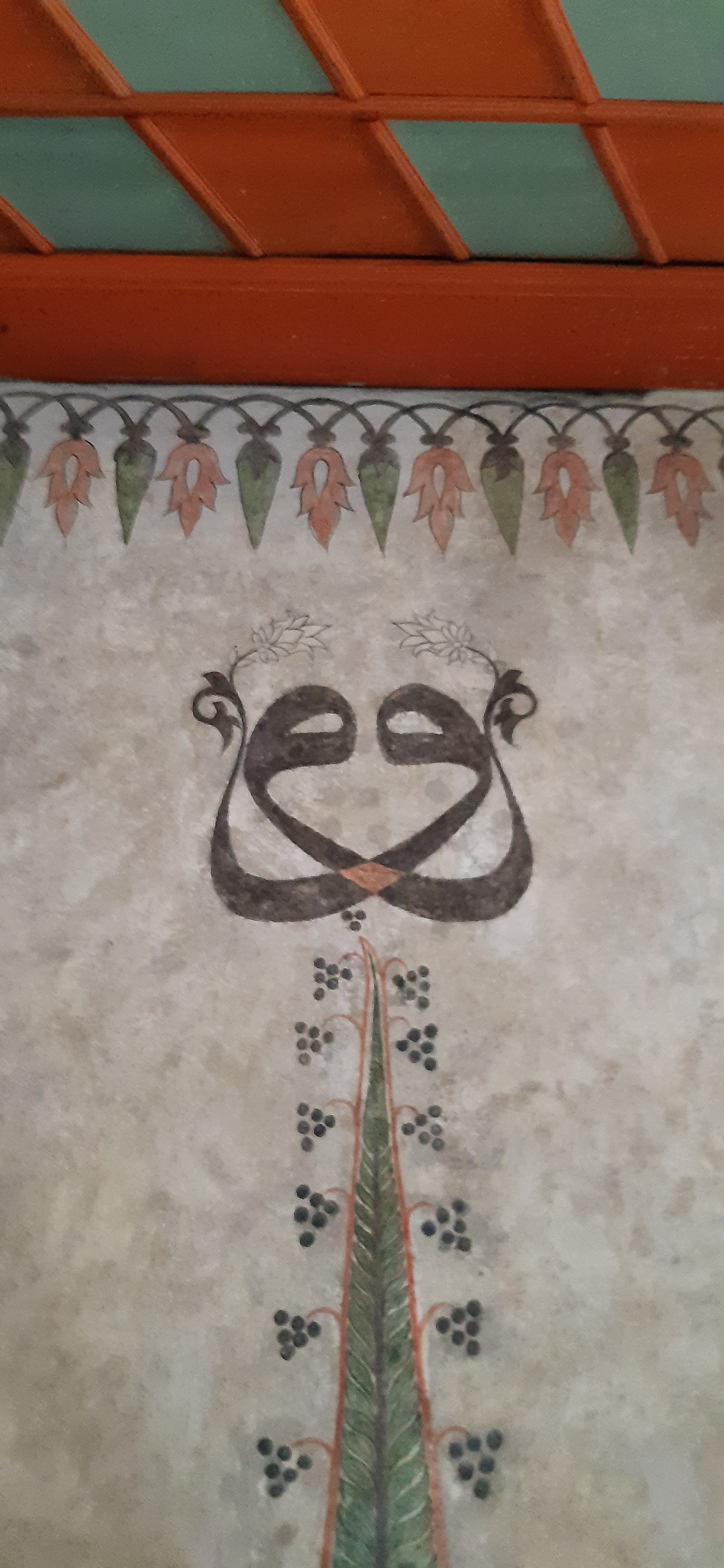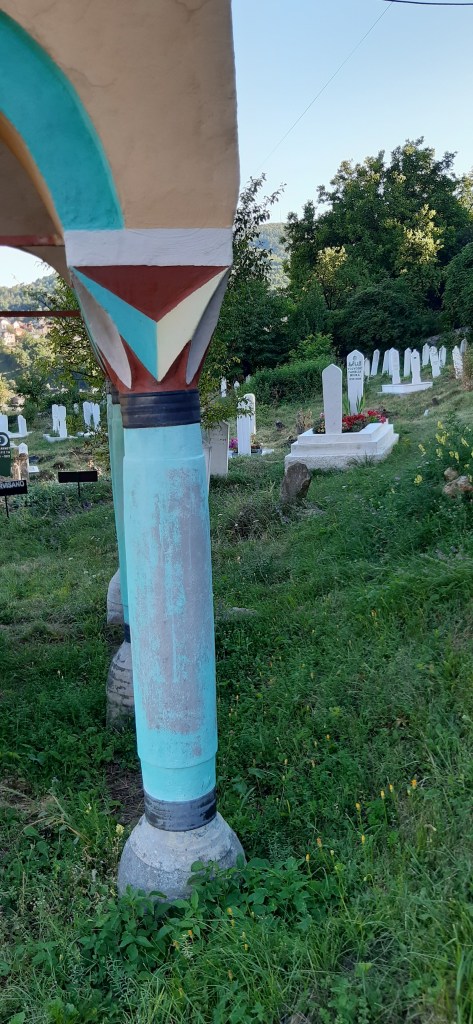La Šarena Džamija di Travnik, la piccola e nobile città della Bosnia famosa per aver dato i natali allo scrittore premio Nobel Ivo Andrić, è un vero gioiello nascosto, qualcosa di unico e di emozionante in cui è possibile sedersi in silenzio e contemplare la bellezza delle decorazioni policrome.
The Šarena Džamija in Travnik, the small, noble Bosnian town known as the birthplace of Nobel Prize-winning writer Ivo Andrić, is a hidden gem, something unique and exciting where you can sit in silence and contemplate the beauty of its multi-coloured decorations.

Travnik è silenziosa e deserta. Ho deciso di fermarmi qui per due giorni nel mio viaggio verso Sarajevo e visitare questa piccola città dal glorioso passato che si trova a un’ora dalla capitale della Bosnia.
La lettura delle Cronache di Travnik, uno dei capolavori dello scrittore Ivo Andrić che vi è nato, mi aveva incuriosito e volevo verificare se i luoghi descritti nel romanzo fossero ancora riconoscibili.
Travnik nella sua parte antica si allunga su un pendio che risale verso un’antica rocca di epoca ottomana, costruita all’epoca in cui questa cittadina era il centro amministrativo della regione. Numerosi minareti puntaggiano il nucleo antico, bianchi segni di moschee antiche, ma nulla farebbe pensare che la più bella e famosa, la Moschea Sulejmanija, conosciuta come Moschea Dipinta, che è il luogo più bello e affascinante non solo di Travnik ma forse dell’intera Bosnia, si trovi a valle, affacciata su una piccola piazza attorno a cui oggi si affacciano negozi e caffè.
Travnik is quiet and silent. I decided to stop here for two days on my way to Sarajevo and visit this small town with a glorious past that is an hour’s drive from Bosnia’s capital.
The Bosnian Chronicles one of the masterworks of Ivo Andrić, who was born here, had intrigued me and I was curious to see if the sites depicted in the novel were still recognisable.
Old Travnik stretches up a slope towards an ancient Ottoman-era fortress, built at the time when this town was the administrative centre of the region. Several minarets dot the old core, white markers of ancient mosques, but nothing would indicate that the most beautiful and famous, the Sulejmanija Mosque, known as the Painted Mosque, the most beautiful and fascinating site not only in Travnik but perhaps in the whole of Bosnia, is located down the valley, overlooking a small square around which shops and cafes now stand.

Un edificio su tre livelli, con la facciata decorata da delicati motivi floreali, identifica la Moschea Dipinta, costruita nel XVIII secolo e poi rifatta nelle forme attuali in epoca asburgica.
La guardo dal basso, girandole attorno, e mi chiedo che strana moschea sia questa, ospitata al piano superiore di un edificio simile a un palazzo, destinato in parte a uso commerciale.
L’accesso è nella sua parte posterirore, dove, in una raccolta piazzetta si trova anche la fontana per le abluzioni.
La moschea è chiusa, così mi siedo su un gradino, aspettando che qualcuno si palesi per apirla.
Poi finalmente compare Asim, il giovane ed entusiasta assitente Imam che non solo mi apre le porte della moschea ma si rende anche disponibile a parlare a lungo in un ottimo inglese della storia della moschea ma anche e soprattutto della realtà della comunità musulmana di Travnik e della Bosnia. Il discorso è al tempo stesso affascinante e doloroso perché, pur nella luminosa serenità di questo ambiente, è difficile scacciare la memoria di un passato tragico e ancora troppo recente per essere dimenticato.
A three-storey building, whose front is decorated with delicate botanical motifs, indicates the Painted Mosque, built in the 18th century and then rebuilt in its present shape during the Habsburg era.
Looking at it from below, walking around it, I wonder what a strange mosque it is, housed on the upper floor of a palace-like building, partly used for commercial purposes.
The entrance is in the rear part of the building, where, in a secluded square, a fountain for ablutions stands.
The mosque is closed, so I sit on a step, waiting for someone to open it.
Then finally Asim appears, the young and enthusiastic assistant Imam that not only opens the doors of the mosque for me but also is available to talk extensively in very good English about the history of the mosque and, in particular, about the reality of the Muslim community of Travnik and Bosnia. The talk is both fascinating and painful because, although we sit in the bright serenity of this room, the memory of a tragic past, too fresh to be forgotten, is hard to dispel.





“Ci sono solo solo due moschee dipinte nei Balcani – ci dice Asim visibilmente orgoglioso di essere il custode di questo gioiello- questa di Travnik e quella di Tetovo nella Macedonia del Nord che porta il medesimo nome (Šarena džamija, moschea dipinta).”
Immediatamente mi viene voglia di partire, sconvolgendo i miei piani di viaggio, perché se anche quella moschea macedone riuscisse a trasmettere le medesime emozioni di quella in cui mi trovo sarebbe davvero una deviazione emozionante.
Purtroppo non riuscirò a realizzare questo progetto e la moschea di Tetovo rimarrà un progetto per il futuro ma i momenti passati con Asim nella moschea Sulejmanija di Travnik resteranno per me indimenticabili.
“There are only two painted mosques in the Balkans,’ Asim tells me, visibly proud to be the keeper of this gem, ‘this one in Travnik and the one in Tetovo in North Macedonia with the same name (Šarena džamija, painted mosque).
Immediately I wish to start, disrupting my travel plans, because if this Macedonian mosque also could communicate the same emotions of the one I am standing in, it would really be an exciting diversions.
Unfortunately, I will not be able to realise this project and the mosque in Tetovo will remain a project for the future, but the moments spent with Asim in the Sulejmanija mosque in Travnik will remain unforgettable for me.

Salendo al piano superiore, nell’area riservata alle donne, si ha una visione ancor più completa e affascinante dell’edificio. Fregi calligrafici, decori, e il bellissimo soffitto ligneo dipinto nei toni del verde splendono nella luce che entra dalle numerose finestre che corrono tutt’attorno allo spazio.
Se la luminosità è la caratteristica principale di ogni edificio di culto ottomano, in questa moschea elegante e insolita, anche perché priva della cupola che è un segno distintivo di questa architettura, essa raggiunge livelli poetici, esaltati dalla vivacità dei decori.
Ritorno più volte nella moschea, in ore diverse del giorno, scoprendola sempre diversa nella luce declinante nella sera o in quella sorgente del mattino.
Ascending to the upper floor, in the women’s section, you have an even more complete and fascinating vision of the building. Calligraphic friezes, decorations, and the lovely wooden ceiling painted in shades of green shine in the light coming in through the many windows lining the space.
If brightness is the main attribute of every Ottoman religious building, in this elegant and unusual mosque, due to the lack of the dome a distinctive feature of this architecture, it reaches poetic levels, enhanced by the brightness of the decorations.
I have returned several times to the mosque, at different periods of the day, discovering it to be different every time in the declining light of the evening or in the rising light of the morning.



Travnik al tramonto si anima. Mentre i muezzin chiamano alla preghiera, nella lunga via pedonale che si addentra nella città asburgica e in quella jugoslava giovani e famiglie si affollano come accade in ogni città europea, specialmente in quelle meridionali, nelle sere d’estate.
Seduti al caffè che si affaccia sulle Acque Blu, un tumultuoso torrente putroppo stravolto da lavori di ristrutturazione, cerchiamo di ritrovare le atmosfere di Andrić ma rumorose comitive di turisti mediorientali rendono difficile il ricordo, affermando però con la loro presenza la particolarità di questa città e di questa terra che pur essendo apparentememente europee vivono e respirano d’Oriente.
Travnik comes alive at dusk. As the muezzins call to prayer, in the long pedestrian street that leads into the Habsburg and Yugoslav town, young people and families crowd together, as happens in every European town, especially in southern ones, on summer evenings.
Sitting at the café overlooking the Blue Water, a tumultuous stream unfortunately disrupted by renovation work, we try to recall Andrić’s atmosphere, though noisy groups of Middle-Eastern tourists make it hard to remember, asserting through their presence the uniqueness of this city and of this land which, despite being manifestly European, live and breathe the spirit of the Orient.
Se vuoi leggere un post su Sarajevo leggi qui
If you want to read another post about Sarajevo read here



Un commento